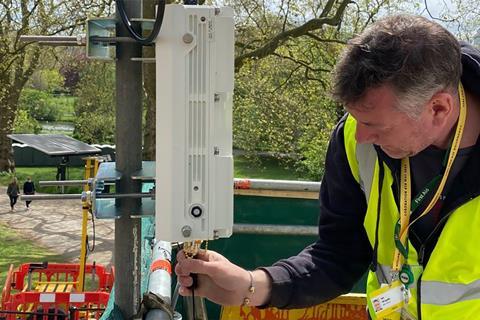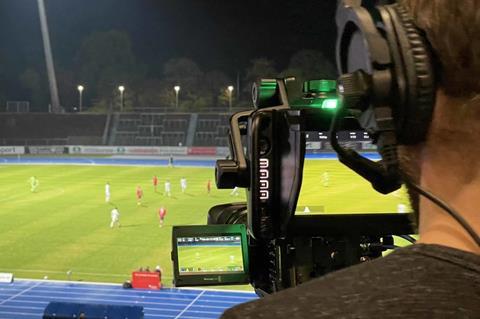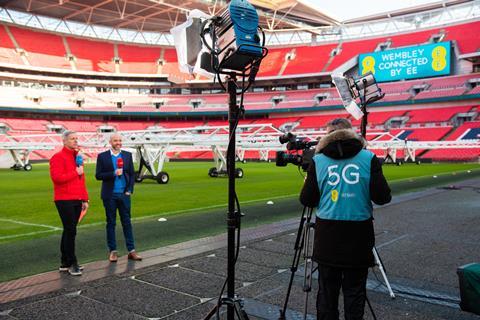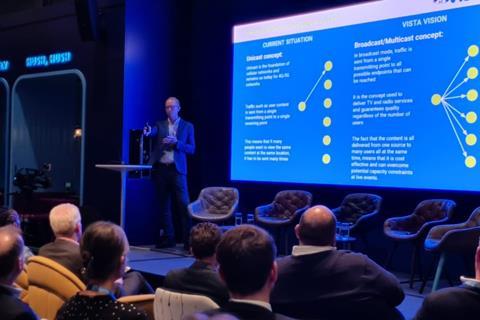5G is one of the hottest topics in broadcasting and, for the media and entertainment sector, the technology will prove to be transformative.
To the average consumer, 5G has not been the world-changing technology it was once sold as. The Internet of Things revolution has so far boiled down to folks using the same digital assistants they had before, and while 82% of premises in the UK can now receive 5G outdoors, the actual speeds available can vary hugely from one road to another.

However, those within broadcast may have noticed the first blooms of an explosion in 5G tech that will change how the industry operates, on multiple fronts, forever.
In just the last few months national broadcasters across Europe have used 5G in production trials of the highest importance. It hugely increases how nimble remote production teams can be.
Meanwhile, other projects are seriously exploring 5G as a broadcast medium. But what are these projects? Here’s an overview of those of the more recent 5G initiatives out there in broadcast.
5G at the Coronation
During the coronation of King Charles, the world’s largest temporary private 5G network was spun up to aid the work of broadcasting partners including the BBC. It nullified the impact of the natural strain on standard mobile communications networks, caused by the crowds gathered to witness the historic event.
This project was executed by Neutral Wireless, a company created by engineers at the University of Strathclyde, with support from the BBC’s R&D department. It provides more than 1Gbps of bandwidth, and was used by broadcasters including the BBC, ITN and Sky — 20 major operations in total.
It is the fruit of a University of Strathclyde team that was part of the IBC Accelerator programme, named Project of the Year 2022, for its “network in a box” 5G solution.
This was one among a series of what the University of Strathclyde has called “proof of concept” trials, including shooting over 5G around the 2022 Denmark national elections. And multiple streams from the Pitlochry Highland Games, which were broadcast directly into the IBC show in Amsterdam.
Sports as a proving ground
Proof-of-concept projects often pinpoint a specific idea or use case. However, a team over in Italy has demonstrated the true scope of one application of 5G in broadcast.

Media Broadcast used a private 5G network to run the production of a football match in Bonn, Germany, doing so entirely over 5G. The team used mobile internet to hook up four broadcast cameras and one roving interview camera to the outside broadcast van. They achieved latency of just 200ms, including the full encode and decode path, straight into the control room.
Read more 5G NR: The Other Side of 5G
It is estimated up to 20 HD-quality camera feeds could be deployed over this same 5G network. This demonstration was a part of a partnership with video encoding specialist Haivision, which has a focus on ultra-low latency video transport.
Back in the UK, in April 2023, Coventry University launched what out described as the “UK’s first 5G Standalone Media Innovation Lab” in partnership with Vodafone. This is an evolution of a project that began in 2020, to use 5G to power VR tours of the body.
It “presents an amazing opportunity for our academics and students to actively participate in the innovation that is driving forward the media and creative industries,” says Dr Shaun Hides, who is Academic Dean at the university’s Faculty of Arts & Humanities.
5G as a medium
These kinds of 5G broadcast production experiments dig into the possibilities of 5G. And they go way beyond the fundamentals of connecting pieces of the capture pipeline, including at events where such connections are crucial, as Malcolm Brew from the University of Strathclyde explained to IBC last year.
“You’re never going to stream live video onto the Nine O’Clock News or capture 4k HDR video, but you could have lots of ancillary things around the wireless camera. You could have microphones, tally lights, all kinds of timecode, generators, genlock, lighting control. It can support all these peripherals, which are very important to a production,” he said.
This widens out further in the context of a live music event. “You have security, you have barcode ticketing, you’ve got to organise 60,000 people and their well-being, make sure that they’re coming to the right turnstiles, and more. What’s nice about 5G networks is you can have one network where everyone’s available,” said Brew. “They’re all on one network which would allow production to speak to Security, and Security to access production camera feeds. It’s potentially much cheaper if you have one network and control the quality of service yourself.”
5G can be used as a medium to communicate between devices, whether the bandwidth requirements are large or small. The use of private 5G networks allows this to happen regardless of how congested the consumer-accessible 5G mobile network is in that area.
It need not require a fresh equipment in all cases either. During an IBC2022 showcase the BBC’s Ian Wagdin explained how a 5G R&D trial saw traditional broadcast cameras made 5G-ready using small circuit board PCs.
“We worked out we were getting around 150-180 milliseconds of latency, glass-to-glass, which is quite impressive. The bulk of that is down to the encoding and decoding,” he said. “We’re looking at how you can drive that down because once you get below that magical 100ms layer you, you can almost intercut this with wired cameras.”
An ability to go wireless without compromise is the clear end point here.
5G production versus 5G broadcast
However, the use of 5G in a production environment is only one face of this technology. Another is where 5G is the actual medium of broadcast.
Rohde & Schwarz showed a demo such a system in action during the MWC 2023 show in February. The collaboration with Qualcomm examines how 5G broadcast can be used to aid in emergency situations, relaying public information alerts and multimedia content to anyone with access to a compatible mobile phone. It doesn’t require the end user to have standard 5G signal, or even for a SIM to be installed in the device.

This same partnership also demonstrated 5G broadcast of the 2022 Eurovision song contest live in Paris, Turin, Stuttgart and Vienna.
A more recent development, Italy’s national broadcaster RAI began its first 5G broadcast trials in March 2023.
360-degree ballet Footage from the Teatro Massimo of Palermo was broadcast to VR headsets in the area over 5G. XR and VR represent a true test for the stability and quality of the 5G streamed experience, the headset view amplifying flaws in the video feed.
Not all of these 5G broadcast initiatives need to focus on the most overtly techy and experiential of use cases, though. Czechia telecommunications company CRA announced the second stage of its 5G broadcast tech in May 2023.
The Zizkov and Strahov transmitters in Prague are used to test the viability of broadcasting TV to regular folks’ mobile phones, as a way to further democratise people’s access to content. “Broadcasting in 5G can bring viewers their favourite programs to mobile phones and tablets without having to use mobile data, it is more economical and more ecological than the current technology,” CEO of CRA Milos Mastník told Broadband TV News.
What’s coming in the future? Two of the picked projects for IBC’s 2023 Accelerator programme are embedded in 5G tech.
5G Motion Capture for Live Performance & Animation seeks to create “video illusion” representing live performances, beamed to completely separate venues over bespoke low-latency networks.
Real-Time XR Sport Edge will broadcast intense sports like MMA within a 3D mixed reality game world, merging video of a real event with a simulated environment. You can expect to hear more about IBC’s Accelerator programme projects during IBC2023, which will take place at RAI, Amsterdam, from September 15 to 18.

One of the challenges around 5G is that it is - at the moment - constantly evolving. Unlike older mobile standards, 5G has been through multiple iterations already, creating a gap between the hardware actually available on the market and the latest theoretical version of the standard. This means that some elements of 5G are available for use today (such as higher bandwidth), others are yet to be included in chipsets, and still others are agreed, but not fully ratified by the 3GPP standards body.
The practical result is something of a patchwork quilt of capabilities, further complicated by varying geographical rollout (some operators have invested more in certain areas than others), and even further complicated by private-sector implementations.
Watch the webinar 5G for live contribution
The latter ‘private networks’ allow organisations to harness the benefits of 5G by essentially building their own networks in a limited area, for example, across a studio complex or sports stadium. The benefits for these early adopters are potentially substantial, enabling the latest hardware and highest network speeds to be reached, without needing to wait for wider public rollout.
5G Standards - what’s going on?
One of the complicating factors when discussing ‘5G’ is that it is not one static specification, rather a list of ‘Releases’, each adding extra functionality onto the base standard. This means that manufacturers and early adopters can begin production and rollout while the finer points of the standards are thrashed out by the standards body, the 3GPP.

Currently, the 3GPP is actively working on Release 18, dubbed ‘5G-Advanced’. Release 17was scheduled for final ratification in Q3 2022, while 18 will span into 2024. Release 17 marks the last 5G ‘New Radio’ Release, and offers several key enhancements of interest, specifically 5G Multicast broadcast, as well as advanced interactive services, multimedia priority service (MPS) and NR eXtended Reality (XR).
5G remote production meets reality
Remote production is one of the earliest and most exciting and developed of 5G use cases. As a much more efficient method of producing live sports, news, entertainment and events coverage than traditional outside broadcasts, it will allow broadcasters to deploy fewer camera operators to events (although many more cameras) and enable staff to work on multiple events a day, located in a centralised studio.
Inevitably, 5G played a key role in the IBC 2022 Accelerator programme, with projects including ‘5G and the Arena of the Future for XR Events’ and ‘5G Remote Production … in the middle of nowhere’ pushing the envelope of what was possible. Looking back a couple of years, an early-stage proof of concept for 5G Remote Production featured in this accelerator project:
This was designed for broadcasters to get an inside track on some of the multi-camera remote production capabilities, challenges and possibilities to come during the very early phases of 5G deployment.
In 2021, an Accelerator looking at the role of 5G in Location-Based entertainment experience in extended realities - or 5G in Location-Based eXtended realities (LBXR) - made waves. Designed to examine how 5G’s low latency and provision of edge computing in particular can amplify important aspects of LBXR’s (Location-Based eXtended Realities) immersive interactivity, technical feasibility, inclusion, and accessibility, the project looked to the gaming market as a testbed.
“Live sporting events provide a real challenge for mobile operators. On match days there are large numbers of people in a stadium and that creates a massive demand for data.”
The demonstration involved the world’s first physical esport, Hado, where players compete on a physical court using head-mounted displays and armband sensors to both see and wield energy balls and shields. The Accelerator aimed to implement a remote play POC - remote play experiments where the two teams compete in different arenas had been tried before, but with the caveat that all the AR elements from the other team can be seen, but the players can’t.

“What we are doing through the Accelerator is solving that,” says Jim Sephton, ex UK team captain and in charge of Augmented Reality sports development with Hado UK.
“We’re working with Noitom to scan the players in real time and we will be merging that data with the Hado gameplay data for the output to viewers. So, we will have two teams in two different locations, and the players and spectators will be able to see a single court created from the data with avatars representing the players.”
Live sport with 5G VISTA and FeMBMS
The 5G VISTA project demonstrated the technical feasibility of using FeMBMS (Further evolved Multimedia Broadcast Multicast Service) technology to enhance the live sports experience in mid-2021, an ongoing project which teams up The Digital Television Group with O2 Telefonica, Digital Catapult, Global Wireless Solutions, and Rohde & Schwarz.
5G VISTA is exploring 5G Broadcast via the 3GPP standard FeMBMS, as it solves some of the crucial challenges in delivering live sporting events, as David Owens, Telefonica head of technical trials explained to IBC 365: “Live sporting events provide a real challenge for mobile operators. On match days there are large numbers of people in a stadium and that creates a massive demand for data.”
Watch the webinar 5G and its impact on content production
“At those key moments (of poor download performance) it is really difficult to stream and post content, and customers are likely to become dissatisfied. This is because the 4G and 5G networks today rely on a TCP-IP service to stream data in a unicast way.
“One source to one customer is just not suited to high demand apps in high demand areas like stadia, and this can cause both perception and physical issues,” Owens added. “Services that could, would and should generate additional revenue can never be implemented.”
The VISTA project has recently (February 2022) completed a successful live trial at a football match in the MK Dons stadium in Milton Keynes, enabling a selected group of fans to use the 5G Vista app to access content. The content was sent over a 5G Broadcast network integrated into the TV broadcast network, and allows fans in the stadium to watch replays and key moments in the game they may have missed.

How 5G could transform production
Much of the conversations around the benefits of 5G for the media and entertainment industry focus on the delivery of content – 5G broadcasting or the benefits of streaming over 5G. But 5G could also be transformative for the creative side of the industry.
The industry relies on many forms of cabling and connectivity to transport pictures and sound, from SDI to IP to satellite. More recently, bonded cellular links have become increasingly commonplace, using 3G or 4G connections to transmit a live video feed – particularly for contribution - over mobile networks.
As BBC R&D senior technology transfer manager Ian Wagdin explains: “Bonded cellular units have revolutionised workflows in newsgathering by allowing journalists and crews go live from anywhere with suitable coverage using a simple backpack or camera mounted device to encode and relay video without the need for large vehicles and lots of cables.”
Read more: Interview with Ian Wagdin, BBC R&D
Immersive media, marketing & brand collaboration
The really exciting aspect of 5G from a broadcast and media perspective is the vastly increased number of concurrent devices that can be supported, as well as an often-mentioned but underplayed 5G feature - network slicing. The latter offers astonishing potential as it allows network managers extremely granular control of network capacity, enabling different channels to be prioritised at different times.
“[We want to] make these productions feel like you’re not just in a broadcast scenario, you’ll feel like you’re at a participatory event, and you’re really engaging with other folks.”
For example, emergency services might have dedicated capacity ‘locked in’ to all urban 5G networks, which would remain available at all times. Equally, a stadium operator could prioritise the camera-to-edit desk links during a sporting event.
Brendan Yam, SVP & general manager, Viacom Digital Studios International told IBC365 that the potential is considerable: “On the visual (‘See’) side of this, we’re looking at different execution, more cameras for example, in some scenarios, turning control over to the users. We’ve seen really strong reactions with things like the VMAs when we launched the ‘Stan Cam’, where fans could follow one particular artist. That was a fixed camera setup, but with this technology we have a lot of opportunity to basically turn that power over to users, particularly as they love to engage with talent – it’s all possible right now, we just have to connect it all together.
Discover IBC Digital XR Producing Immersive Experiences
“On the ‘Feel’ side, what we’re looking to do is actually make these events, or make these productions feel like you’re not just in a broadcast scenario, you’ll feel like you’re at a participatory event, and you’re really engaging with other folks, with the talent, and it feels very much like you’re a part of something live. Then the ‘Engage’ side is really where you can affect the production.”

Yam also observed that 4G turned social media from a desktop application into a mobile application and massively expanded the user base. He predicts 5G will have a similar impact on live and interactive broadcasts. “It will massively extend the use case and the user base for that type of programming,” he said. “Established markets that already have a lot of different media experiences are the ones that are going to really get supercharged. It’s about taking incredible IP that people already know, taking big fan bases that you can already activate, and taking that technological know-how and putting it together. We want to take existing brands and programming to the next level, and then start to create new formats and new options.”
The future - multicast MBMS?
That 5G Multicast broadcast may alone have significant implications for broadcasters, although the details are still very much in the discussion stages. It is thought that the multicase service will initially be limited to supporting general multicast and broadcast communication services (such as transparent IPv4/IPv6 multicast delivery, IPTV, IoT applications and V2X applications), as opposed to stand-along broadcast media services, but there is potential for a high-power broadcast mode specification to be developed too.
Overall, the opportunities offered by 5G broadcast are substantial and far reaching already, and there is still much more potential coming down the pipe. For the immediate future, the probability of delivering live 5G TV services to mobile devices - in the context of a sporting event, movie premiers or live show seems a well-developed use case, and only awaits higher penetration of user devices before rollout. In other words, the future of 5G is very much now…
Discover more about 5G and mobile connectivity, read IBC Tech paper - Delivering on the promise of 5G



























No comments yet